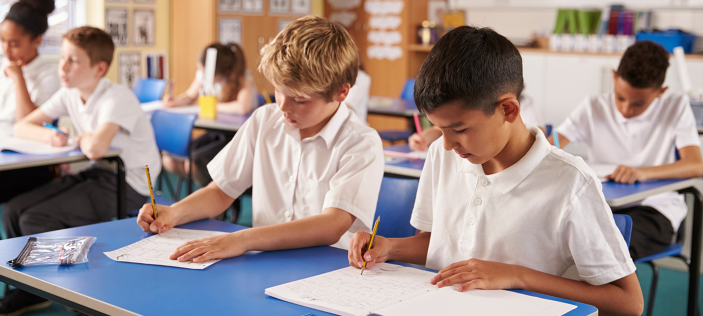
This blog picks up from my previous post The Long and the Short of GDS in Year 6 Writing. In that earlier post I set out the rationale for a series of related blogs across the next year, and explained the “long and the short” of the title. This blog focuses on the short term. It is a blog simply concerned with offering support for final writing opportunities before the teacher assessment window closes.
The grid below hopefully clarifies the distinction I am drawing between these short and the long term views. If you just want to crack on with this particular post’s year 6 advice – because time is short – just scroll past the grid without a shred of guilt in your heart.
The long and the short of GDS
|
The long |
The short |
|---|---|
|
|
A quick recap
Last time around, we looked at each of the bullet points from the 2017-18 Teacher Assessment Framework (please note: the TAF, no longer the ITAF). In the course of doing so, one emerging theme that came through was the influence of personal reading in the children’s writing. I made the point that this doesn’t mean parading overt influences, and it certainly wouldn’t mean parroting a text (unless we are quoting, say, or mimicking some phrasing for devastatingly clever, satirical effect - quite a risky task in itself).
What it really means is that in the course of reading the child’s evidence bank, we should have a sense that they have been reading a range of what might be termed (and debated no doubt) “age appropriate + books”. Put it this way, I love Don’t Let the Pigeon Drive the Bus with all my heart, but its influence is unlikely to bunk us up and over the EXS/GDS trellising.
By 'reading that informs writing', we mean understanding the text, absorbing its mode and message, getting a feel for the rhythms and patterns of writing in its many forms and from this, accepting and rejecting stylistic turns, language features, and punctuation quirks. This process, this evolution of the young writer, happens bit by bit, and is in many ways invisible to the human eye, just like physical growth, as they develop that thing called “voice”.
That voice will change or vary; in terms of statutory assessment, it has to as the requirements around formality expect children to manage the formality level that they have adopted consistently. The formality level needs to reflect the purpose of the given stretch/piece of writing. Remember though, the requirement to shift about in formality within a piece has been sensibly put to sleep – you can shift about if you’re that way inclined, or the text warrants it, but the measure now is purpose and control. If it needs to be formal throughout, then keep an eye on those inappropriate slips.
Furthermore, if you consider the slips in GDS pieces C and D of the moderator training materials (published in NCA tools and currently on Michael Tidd's blog, under KS2 teacher assessment moderation pack 1), you will have a good idea of what to look for.
A closing tip for this section: formality does not tend to trip off most people’s tongues. Reading. Rehearsing. Modelling. Repetition. That will help. Providing speaking frames for unfamiliar or complex constructions can be hugely powerful, especially if backed up with some light touch discrete sentence practice. Choosing a form and context that does not overload your children so that they can focus on careful drafting and meticulous editing will also help.
Just right reading

I have a conundrum when it comes to GDS. I am glad it acknowledges the long-term commitments of the avid readers and most writerly writers in our midst. This commitment to the life of the reading mind is not always fully recognised. What, though, of those that do not devour books at a rate of knots? What of our less keen - or perhaps less attentive reader? For them we may need to look at what seems like a shortcut: we may need to arrange a literary fuel injection. How do we do this without feeling as if we are cramming or hot-housing simply for the sake of SATs and stats? Simple. If we are short of time, we shorten the reads. This might, for now, be a short blast in the run up to this year's assessment deadline, but equally the provision of high quality, but shorter texts will likely have benefits for certain types of readers across the years, across the phase.
I love books. They sort of rule my life. Anyone that has followed me on Twitter or spoken with me at an event will know this to be true. Still, I have no qualms in pointing you to high quality collections of short stories. We often talk of reading stamina, and how this feeds into achievement, and springs forth from fluency. All true. Children need to read books. However, short stories (not to mention poetry) have their place too, and equally - possibly more effectively - develop fluency and stamina, when chosen well. They provide a more singular, contained, and complete reading experience, and the effect may well be profound in terms of developing a child's sense of narrative structures, and to allow the reader to really feel the fullest effect of a narrative's closing moments. Try reading a short story that does not end happily, or isn't wrapped up neatly or justly, to your class. You will likely get some collective insight into what we really mean by effect on readers from just such a session: powerful learning right there in a contained, shared moment.
A story that subtly makes use of figurative language and stylistic features (anaphora, single line paragraphs at pivotal moments, a well placed, unobtrusive flashback, for example) can influence writing without you highlighting it. Carve out space for your reader-writers to read/mull/absorb and you will see the benefits in due course. This does not all have to happen within the confines of the classroom and amidst the pressures of the timetable. Reading a powerful, thought-provoking story at home will likely go down far better than usual home-reading routines for our more reluctant readers. I'll be returning to reading cultures in the longer term view blogs.
Done well, short stories are a precise art form, just like poetry, and they are perfect when time is short. I think they have a major, sometimes underdeveloped, part to play in schools. I also think that they need to be a little more carefully distributed too - I have heard Stone Soup just a few too many times in my time as a teacher and I know some of my children have. The range out there is too rich to limit the diet so. To help in this regard, I have written a supplementary blog, that sets out the substantial benefits and provides a list of some hugely exciting, enriching titles.
My personal favourites from the list for Year 6 would include Uncle Montague's Tales of Terror, as it draws upon the masterly work of my beloved M R James. More on this in the following section. Another favourite is the fantastically Irish-and-proud Once Upon a Place. A great range of authors and the wonderful illustrator P J Lynch cover a range of story types. I would make particular mention of the story Number 13 and if you want a great way to get children desperate to read this pretty scary story, just send me an e mail using the address at the foot of this blog. I am keeping this particular lesson idea mysterious, just like this brilliant story. I am also legally obliged to mention Bradbury’s All summer in a Day, too, at this point, but I have said enough on that gem in the past.
If fiction does not cut it with your particular aspiring GDS achiever, look to the reliably great The Week Junior for high quality articles and features on a diverse range of topics, but of a consistently high quality. I would also highly recommend the gripping Survivors by David Long and Kerry Hyndman. Any book that opens with someone falling out of a plane, as it crosses the Amazon, gets my hearty vote. It really does go down a storm in class. Then there are short-form biographies, but more on those shortly. Survivors also supports recount writing, which brings me ever so neatly to the next section.
Moving on: narrative writing

As well as directing our energies to shorter form writing in the coming weeks, we might also consider reducing overload by focusing on developing strengths in a more focused body of writing. In previous years, the ITAFs had a built in requirement that a short story formed a part of submitted evidence banks. This no longer applies. We now have references to ‘narratives’ in both the WTS and EXS standards (as exemplified here in the EXS statements):
- in narratives, describe settings, characters and atmosphere
- integrate dialogue in narratives to convey character and advance the action
‘Narratives’ refers to both fiction and non-fiction and, to my mind, recounts generally represent a worthwhile investment of the remaining time. Recounts cover a range of text types: reports; diaries, biographies and autobiographies. My first piece of advice in terms of making best use of time is to bring recounts into the mix of the fiction work that you undertake. Let’s say we have used guided reading time to look at the first, and highly effective, chapter of Uncle Montague’s Tales of Terror.Classic recount. Get through the woods and arrive at the not-at-all-safe confines of Uncle Montague’s cottage. You may want to look at this very recent blog on recounts, written specifically in support of this blog; it is directly relevant, focusing as it does on a sequence of texts to support recount writing based in some rather scary woods. The experience of journeying from A to B via some curious landmarks lends itself to classic storytelling, but also to diary writing, letters – the works.
There is nothing to say that you cannot double up. Tell a story. Write a letter. Draw out a character through diary writing. It’s worth noting that Frankie, our GDS exemplification pioneer and veteran of three frameworks now, does just this.They play to their strengths: an explanation related to ballet and an autobiographical account of a ballet performance; a report based on Morpurgo’s Giant’s Necklace and a diary entry based on the same. Of those four pieces, that’s three recounts. The dual narrative of the visit to the fridge at night would fit in the bracket of narrative so we are drawing upon some common knowledge/skills strands, chiefly chronology, which done well, supports cohesion. Cohesion is our friend. For GDS, we just need to bring it to life through descriptive detail, authorial comments, reflections and pointers. I would like to briefly refer here to what Barrs and Cork's The Reader in the Writer (CLPE) called 'breaks in the time sequence'. Our strongest writers should have the confidence to know - in the course fo drafting and revising - when to tell a story, and when to almost step out if it - to linger, or comment on a detail, to have a thought. I'll be referring to both this book and this concept in more detail later in the year. Just to wrap up this paragraph, and in reference to Frankie's balletic pieces, there is something, too, about allowing children to work with confidence in areas that they know, or care about – ideally both.
I have also blogged on biographies in support of this particular set of advice. Much like the blog on short stories, this offers up a range of titles that are high quality in content and presentation, but that will not require excessively long reading periods; they are perfect for modelling all the standard, functional requirements for the form, but also in the way that they offer up particular turns of phrase, curiosities, and 'breaks in the time sequence', once again, to add real interest and verve to our writing approaches. Look, too, to quotes from research. Harking back to the long-gone days of level 6, one of my best ever writers cut me to the quick by including a final, devastating quote centred on the final moments of Dr Barnado. It was a perfect choice, perfectly placed. It showed a wonderful control of content. It said "call me level 6 by all means but I am aiming for something a bit deeper than that, thank you very kindly." I can still remember its effect quite vividly at the end of a long night of marking.
Biographies are a personal favourite for drawing out great writing, but they might take longer as we are going to need to build in time to research, though this may well have happened across the curriculum. They used to form part of what I called the ‘expert text’ strand of my teaching in year 6. I’ll be talking about that in greater depth (ahem) when I look at longer term concerns relating to developing strong, confident writers – curriculum design in particular. For now, biographies may be worth considering as they can draw upon the content taught in other curricular areas, or from the children’s own interests and passions. They are ideal texts in that they are not a massive leap from storytelling. They are storytelling. They move through time. Events occur. Things tend to change. There are some incredible books to guide and inspire your children to bring their chosen subject to vivid, documented life. Queen of the Falls by Chris Val Allsburg is a standout, as described in that last linked blog that I put together to support this piece. Do check out the link, there are some incredible texts there that would enrich any classroom.
Though not in the TAF as an explicit statement, biographies are also a good vehicle for demonstrating a sure grasp of verbs and I continue to maintain that verb forms are a reliable indicator of a promising writer. I don’t mean flinging around complex synonyms for simpler terms (this is one myth, or misinterpretation, that I have had to address at an out-of-county cluster). I mean developing a sure grasp of managing the ebb and flow and the stormier waters of the writing – taking us forward, back or holding us in time as the piece requires.
A shorter dash to the end
I just want to round off with some quick tips that I hope to expand on in a subsequent blog. They are geared towards nudging the writing process towards something that reflects the realities of writing outside of the primary (year 6?) classroom.
- keep in mind that the curriculum is very clear on the importance of planning, drafting, revision, editing, and publishing. All play their part. Spending longer on fewer pieces will likely pay dividends – but with plenty of deliberate practice woven into teaching sequences
- think about the reader in the writer (I shall definitely be revisiting this with more explicit reference to CLPE’s seminal book that is likely to pop up again in this series). Listen to their interests. Be open to their ideas about what they would like to write. Encourage this to extend beyond the confines of the classroom by encouraging private writing and celebrating anything shared from outside school
- time is short but dialogue deserves a slice of it, both in terms of peer-to-peer feedback, but also in terms of exploring ideas, weighing up options, suggesting and evaluating constructions. It is just as important for higher attaining writers as those that find writing more challenging
- time too, is the writer’s friend and enemy. Do we carve out enough time and sufficient headspace for children to write to the best of their abilities? To get florid, do we give them that freedom to pick up an idea, run with it mentally as if it is a windy day playtime and see where it ends up. If we know where we are heading in terms of a writing outcome, why not share it well in advance so that as we move through the stages of reading, exploration and practice, ideas can form, dissolve or crystallise. Splitting a piece of writing around a weekend can really help to sharpen and reform those initial, tentative ideas
Well that is that for now. You will be up-past-your elbows in SATs at present, and I wish you and your children the very best (in every sense) with that, but I hope that this proves to be of use for those of you that have a little further to go in terms of being ready for the writing assessment deadlines once SATs week is over. If you have any queries, or would like me to elaborate any further on any of the above, do get in touch using the e-mail address below.


